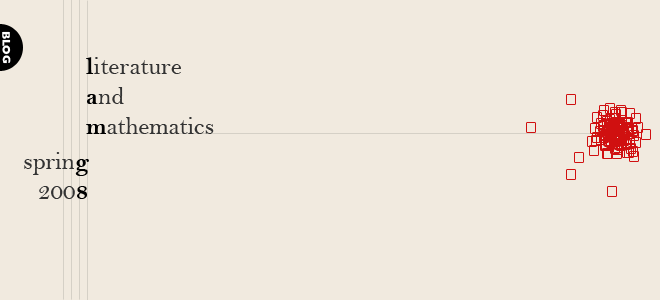I was thinking today about Abbot’s Flatland: A Romance of Many Diminsions, and the similarities and differences between Abbot’s imaginary world and that of Tomasula. Both novels are social commentaries of sorts, with strikingly similar arguments. Abbot illustrates the naïve nature of Flatlanders and their incapability of imagining a third dimension or the benefits of a different social structure. Tomasula quotes Goethe’s assertion that we are “the organs of [our] century, which operate mainly unconsciously,” to open his novel. Abbot goes very in depth in his description of how we, in the third dimension, should visualize his Flatland. He also vividly illustrates how Flatlanders perceive each other and how this is different than our perception of them. Tomasula uses the setting of Flatland mostly as a rhetorical device. It is apparent that Square, Circle and Oval are not physically limited in two dimensions as the characters are in Abbot’s novel. However they are still driven by their society, which I believe is Tomasula’s main point in Vas. With continued advancements in science, it has become increasingly more difficult for the characters in Vas to maintain the same ethics as in the past. I believe that the characters in Abbot’s Flatland are products of their dimension, while those of Tomasula’s Flatland are products of their generation, all of which are ruled by limitations.
Subscribe to:
Post Comments (Atom)

4 comments:
yeah spot on... he talks about what he wanted to get across through vas using flatland in this interview
http://www.cybcreateconnect.com/SL/transcript.html
This is really interesting. I wonder how much reading the original Flatland would have helped in understanding VAS. I'm assuming that VAS is at least loosely based on some of the ideas of the novel besides the characters being called Square, Circle and Oval.
I originally looked for closer connections between Abbot's Flatland and VAS, but came to agree with you, that it is mainly a rhetorical device. I was introduced to Flatland by my brother and didn't realize until I looked it up that it was produced in the late 1880's; I was fooled into thinking it was a lot more modern.
Thanks for the link! The beginning of the discussion hits on another aspect of the VAS that I found particularly interesting, gender roles.
I didn't initially pick up on the fiminist nature of Vas. That interview was interesting!
Post a Comment